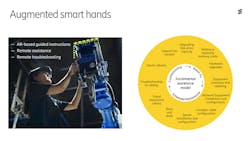By ENRICO ROCHETTI, Ericsson -- There is a growing interest in augmented reality (AR), and immersive experience has been inserted among Gartner’s Top 10 Strategic Technology Trends for 2019. Besides the logical interest from an end-user perspective, analysts agree that the use of 'mixed reality' with hands-free devices will help increase productivity in an industrial environment. Ericsson recently launched itsd Augmented Reality Smart Hands services, the evolution of the Ericsson data center operations offering based on a hands-free mixed reality solution developed in collaboration with Mobiliya.
Data center - a declining business?
Analysts have anticipated that many leading enterprises will migrate entirely away from their corporate data centers with the current trend of moving workloads to colocation, hosting and the cloud. Although the business overall shows a declining trend, in the telecom sector service providers continue to invest to keep their IT in their on-premise data centers, and the long tail of their investments in private cloud, or under the constraint of data residency requirements.
CIOs are continuously seeking ways to monetize these investments offering hosting and colocation to enterprises, but as the market prices are expected to decrease in coming years, it becomes critical for service providers to address the cost side if they really want to transform data centers into profit centers.
More and more service providers embark in consolidation and modernization initiatives with the purpose of achieving cost efficiencies through the adoption of new technologies that optimize the utilization of floor space, power and cooling. And on the infrastructure management front, they pursue efficiency through operational transformation and the adoption of intelligent automation. This is where it is key for service providers to drive efficiency by partnering with proven Managed Services Providers (MSPs), to outsource or co-source technology and facility-related operations of data centers and infrastructures that can offer lower operational costs by leveraging on larger economies of scale.
Vertiv joins Ericsson Energy Alliance in push for 5G access networks deployment
Driving efficiency with augmented reality
For MSPs, differentiating in a commoditized market like data center outsourcing is challenging. A strict industrialization process and standardization of services is required to really enable economies of scale. This includes levers like process optimization, service automation, a worldwide presence with the right mix of local competences and global Network Operations Centers, and attractive and transparent commercial models. But it is only investing in innovation that MSPs will be able to create additional value with the adoption of new and emerging technologies, and this is where we think that augmented reality will play a role in coming years.
Besides the logical interest from an end-user perspective, analysts agree that the use of augmented reality with hands-free devices will help increase productivity in an industrial environment.
Augmented reality is the real-time use of information in the form of text, graphics, video and other virtual enhancements integrated with real-world objects. It aims to enhance users' interaction with the real physical environment.
Mixed reality takes AR to the next step, it uses inside-out tracking to sense the space and objects around the user to enable holograms to have realistic interactions using the surfaces in the room and enabling the user to manipulate the holograms with their hands using gesture control.
In data centers, augmented reality and mixed reality will give users the ability to better interact with the environment, having contextual information always at hand and empowering technicians to execute maintenance work at faster speed, lower costs and unaltered quality.
So, how will AR improve productivity and create more efficiency? We will use mixed reality in two core scenarios:
- AR-based hands-free guided instructions to help executing complex maintenance work, such as rack and stack, and structured cabling. A mixed reality application will walk engineers through mounting and installation workflows, providing visual enhancements through holograms such as mounting positions and cabling sequences, and always keeping design and lay out information at hand
- Remote AR assistance to instantly put certified experts from our global Network Operations Centers anywhere in the world for troubleshooting and support. They will reach out to on-site engineers on AR hands-free devices, share a real-time view of the data center environment, and interact with it by creating holographic markers to designate the objects of maintenance suggesting corrective actions
Benefits for customers
More concretely, the use of hands-free augmented reality will allow for the adoption of an incremental workforce model with decentralized pools of lower and more generic skillsets carrying out the day-to-day manual work in service providers' datacenters, and pools of more senior capable and certified resources located in our global Network Operations Centers available for remote operations, design and assistance.
This will save time and speed up the maintenance work, increase the availability of IT infrastructure, and generate efficiencies by cutting the costs of dispatching senior service technicians.
Ericsson Augmented Reality Smart Hands services will be provided on a hands-free augmented reality solution based on Microsoft HoloLens developed in collaboration with Mobiliya.
Want to hear more or join a live augmented reality experience? Come and see us at the Ericsson hall 2 at MWC 2019.
ENRICO ROCHETTI is Global Portfolio Director within the Managed Services IT and ADM Service Area in Business Area Managed Services at Ericsson.


